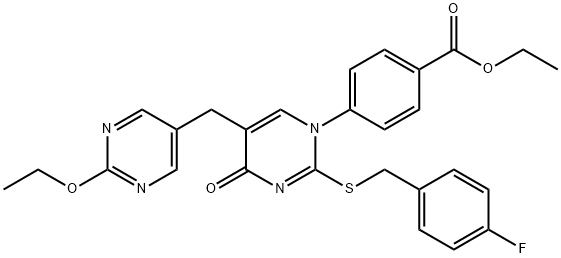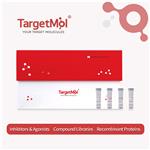GW1100 (306974-70-9) is a selective antagonist of GPR40. GW1100 inhibits GRP40-mediated Ca2+?increases stimulated by GW9508 (Cat.# 10-1108) or linoleic acid (pIC50?= 5.99 for either agonist).1?The effects of GPR40 activation on insulin secretion in cells are also blocked by the addition of GW1100. GW1100 does not influence calcium mobilization mediated by GPR120.
GW 1100 is a selective G protein-coupled receptor GPR40 antagonist. GW 1100 has been shown to reverse the effects GPR40 agonists which induce glucose-stimulated insulin secretion.
GW-1100 is a selective GPR40 antagonist with pIC50 of 6.9.
GW-1100 (GW1100) dose dependently inhibits GPR40-mediated Ca 2+ elevations stimulated by GW9508 and linoleic acid (pIC 50 values of 5.99±0.03 and 5.99±0.06, respectively). GW-1100 at a concentration of 1 μM produces a significant rightward shift in the concentration-response curve to GW9508 (pEC 50 =7.17±0.08 in the absence and pEC 50 =6.79±0.09 in the presence of 1 μM GW-1100; P<0.05; n=3). At concentrations of GW-1100 of 3 μM and higher a significant decrease in the maximal response is observed with a continuing rightward shift in the pEC 50 response. GW-1100 (GW1100) reduces FFAR1 ligand-induced intracellular calcium in CHO-K1/bFFAR1 cells and neutrophils. CHO-K1/bFFAR1 cells are incubated for 15 min with 10 μM GW1100 or vehicle (0.1% DMSO) and then stimulated with vehicle, oleic acid, linoleic acid or GW9508. GW-1100 significantly reduces the increase in intracellular calcium induced by 300 μM oleic acid (AUC (60-150 s) , p<0.05), 100 μM linoleic acid (AUC (60-150 s) , p<0.05) and 10 μM GW9508 (AUC (60-150 s) , p<0.05).
The intracerebroventricular injection of DHA (50 μg) and GW9508 (1.0 μg), a GPR40-selective agonist, significantly reduces mechanical allodynia and thermal hyperalgesia at day 7, but not at day 1, after CFA injection. These effects are inhibited by intracerebroventricular pretreatment with GW-1100 (10 μg), a GPR40 antagonist.
1) Brisco?et al. (2006),?Pharmacological regulation of insulin secretion in MIN6 cells through fatty acid receptor GPR40: identification of agonist and antagonist molecules; Br. J. Pharmacol.,?148?619
2) Nagatake?et al. (2018),?The 17,18-Epoxytetraenoic acid-G protein-coupled receptor 40 axis ameliorates contact hypersensitivity by inhibiting neutrophil mobility in mice and cynomolgus macaques; J. Allergy Clin. Immunol.,?142?470 [Focus Biomolecules Citation]


